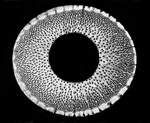|
Chronology
JAPAN 2 • 1233-1477
JAPAN 1233-1477 - THE AGE of the 'TANTEKI' SHAKUHACHI
- the "short flute" in "field music" theatricals, at the Imperial Court,
and in the shrines and temples ...
13th CENTURY:
短笛 - TAN-TEKI - "Short Flute"
目闇法師 - ME-GURA HŌSHI - "Blind Monk(s)"
1233 - KYŌKUNSHŌ
短笛ハ尺八云、今ハ目闇法師猿楽吹之、
或書云、尺八ハ、昔西國ニ有ケル、
猿ノ鳴音目出カリケル臂ノ骨、
一尺八寸ヲ取テ、
造テ始テ吹タリケルナリ、
仍名尺八也。
"[As for] The short flute (tan-teki), that is called shakuhachi.
Nowadays [1233], blind lay monks [i.e.: biwa lute players] and saru-gaku [i.e.: pre-Nō theatre performers] are playing it.
It is being told in a certain book that the shakuhachi has been in existence in the Western Provinces [of China] since times of old.
The sound of monkeys singing - an auspicious bone of the elbow;
taking the measure of 1 foot 8 inches and preparing it
- then you can blow it.
That is why it is called shakuhachi."
Quotation from Ch. 8 in the court dance treatise
'Kyōkunshō' by Koma Chikazane, 1177-1242,
a musician-dancer at Kōfuku-ji in Nara.
Sources: Koji ruien & Koma no Chikazane, 1928.
Trsl. by Torsten Olafsson, 2010.
The narrative about the monkeys is also told in the
'Taigenshō' music treatise of 1512.
It is quite probable that the blind reciters of
the 'Heike Monogatari', the biwa-hōshi, used the
"short" shakuhachi as a tuning device; cp. the picture in
the 'Shichijūichi-ban shokukin utaawase emaki', ca. 1501.
1238:
聖徳太子伝私記 - SHŌTOKU TAISHI DENSHIKI
古今目録抄 - KOKON MOKUROKU SHŌ
The Imperial Crown Prince Shōtoku Taishi Legend
Dated in 1238, the monk Kenshin,
顯真,
of the famous Hōryu-ji Temple in Nara recorded this quite short anecdote about the late 6th century (semi-legendary) Imperial crown prince Shōtoku who,
allegedly, played the shakuhachi while ceremonially parading from one important Nara temple to another:
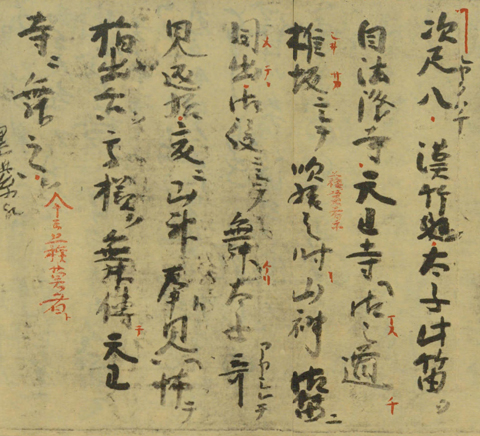
The Imperial Prince Shōtoku Taishi shakuhachi fairytale, dated 1238
「尺八,漢竹なり。
太子此笛を法隆寺より天王寺に御(い)ますの道,
椎坂にして吹き給いしの時,
山神,御笛に目して出て御後にして舞ふ。
太子奇(あやし)みて見返し給ふ。
爰(ここ)に山神,見奉りて,怖れて舌を指出づ,其様舞ひ伝へて天王寺に之を舞ふ。
今に蘇(そ)莫(まく)者(しゃ)と云ふなり。」
In the rendering of Swedish shakuhachi researcher Gunnar Jinmei Linder, this is the narrative that Kenshin messaged back then:
"The Crown Prince played the Chinese bamboo flute shakuhachi as he walked the honourable way from Hōryū-ji to Tennō-ji, and at Suisaka, the Mountain God heard the reverend flute and came out dancing behind the Prince."
Also, Kenshin's text first states that "The shakuhachi is a Chinese flute". And, it concludes that the title of the legendary mountain spirit's dance was then, in 1238, known as
'Somakusha', 蘇莫者.
Back in 1954, Eta Harich-Schneider explained about 'Somakusha' like this [1954, p. 74]:
"A dance of Indian origin. A Japanese legend tells of a mountain spirit who once appeared to prince Shōtoku Taishi, when the prince was playing the flute on a mountain in Yamato. The mountain spirit took delight in the melody and danced to it.
Two musicians act in this dance: the dancer, dressed in a straw mantle, represents the mountain spirit; the flute player, dressed in kingly apparel, represents Shōtoku Taishi.
The famous Tōdaiji fluteplayer in Nara is said to be an illustration of this dance."
This shakuhachi fairytale about Prince Shōtoku Taishi has gained widespread popularity - and mistaken credibility as a "true" story - among orthodox shakuhachi traditionalists, but we cannot accept Kenshin's account in any way as historically evidenced and trustworthy.
Online sources:
Gunnar Jinmei Linder's shakuhachi website: About, 1.3.1 Early Buddhism
2013 Gagaku shakuhachi research article by Akedo Shin-ya
The National Diet Library scanning of the 1238 Shōtoku Taishi legend - go to frame 12
The Tokyo National Museum scanning of the Shōtoku Taishi legend
Printed source:
Eta Harich-Schneider, 1954, p. 74.
明鏡 - MYŌKYŌ
DŌGEN and THE MIRROR OF CLEARNESS
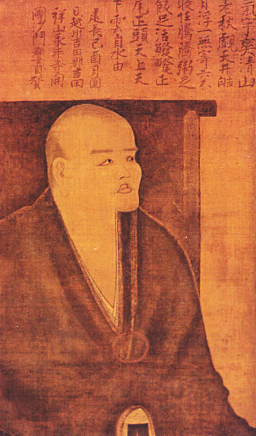
Portrait of Dōgen, c. 1250
- - -
圜悟禪師イハク。
稽首ス曹谿眞古佛ト。
シカアレハシルヘシ大鑑高祖ノ明鏡ヲシメス。
「本來無一物何レノ處ニカ有ラン塵埃ナリ。
明鏡ハ非臺ニ。」
コレ命脈アリ。
功夫スヘシ。
明明ハミナ明鏡ナリ。
カルカユヱニ明頭來明頭打トイフ。
イツレノトコロニアラサレハイツレノトコロナシ。
- - -
- - -
"Zen Master Engo said,
'The one I am respectfully bowing to is the Old Enlightened One [lit.: "Old Buddha"];
such it is that we must appreciate the saying of that venerable Founder Daikan [Enō, the 6th Zen patriark Huineng],
"Essentially, not a single thing exists, so in what kind of place can there possibly be dust and dirt?
The Clear Mirror is not a stand [for dresses].'
This decree contains the blood of life [lit.: "veins"].
We should make great effort [to comprehend it].
The Clear Mirror is everything that is bright and clear.
Therefore it is said, 'Clearness comes, Clearness hits'.
As there is no 'where?', there is no 'what place?" [it can be]."
Quoted from the 'Shōbogenzō' by the Sōtō Zen master
Dōgen, 1200-1253. Trsl. by Torsten Olafsson, 2011.
Source: The SAT Daizōkyō Text Database, Tōkyō.
1254?:
No, no, no - and NO, again:
Shinchi Muhon Kakushin a.k.a. Hottō Enmyō Kokushi never imported a Chinese shakuhachi tradition to Japan,
nor did he ever have any "disciples" who played any kind of "Buddhist Shakuhachi Tradition", whatsoever.
Please do just forget all about that, once and for all!
念仏 - NENBUTSU
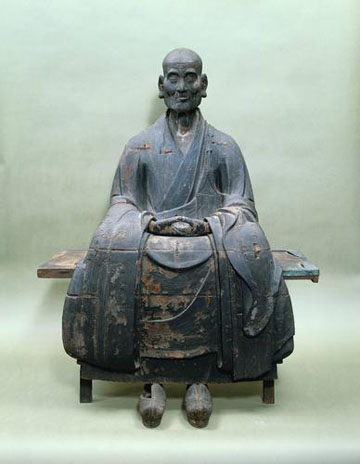
Hottō Kokushi/Shinchi Kakushin/Muhon Kakushin - 1207-1298
Wood sculpture, c. 1286. Cleveland Museum of Art
南無阿彌陀佛 - NAMU AMIDA BUTSU
" - - - When Ippen Shōnin met Hottō Kokushi, the founder of the Kōkokuji in the village of Yura in Kii Province, he said,
'I have composed a poem.'
Kokushi said, 'Let's hear it.'
Shōnin recited:
'When I chant,
Both Buddha and self
Cease to exist.
There is only the voice that says,
Namu Amida Butsu.'
Kokushi said, 'Something is wrong with the last couple of lines, don't you think?'
Shōnin then confined himself in Kumano and meditated for twenty-one days. When he passed by Yura again, he said,
'This is how I've written it':
'When I chant,
Both Buddha and self
Cease to exist.
Namu Amida Butsu.
Namu Amida Butsu.'
Kokushi nodded his enthusiastic approval and said, 'There! You got it!'
This was written down in Kogaku Oshō's notes. We should look at them again and again. - - - "
Takuan Sōhō, 1573-1645, in the 'Reirō-shū',
"The clear Sound of Jewels". Trsl. by William Scott Wilson, 1986,
pp. 61-62. Kogaku Oshō, 1465-1548, was a Zen monk
who taught Zen to the Emperor Go-Nara.
Ippen founded the Ji Sect of Japanese Pure Land Buddhism
- Kakushin was strongly influenced by Shingon, Tantric Buddhism.
14th CENTURY:
宮中 - KUCHŪ
1318-1339: EMPEROR GO-DAIGO's SHAKUHACHI (?)
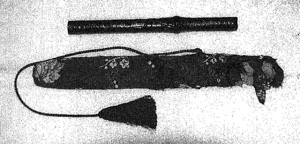
Acc. to tradition, Emperor Go-Daigo (r. 1318-1339) once bestowed this shakuhachi on the Hori Clan in Anō in the vicinity of Yoshino,
Nara Prefecture. Source: Ide Yukio, 1992.
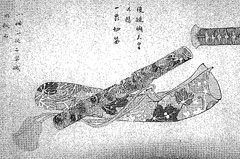
Emperor Go-Daigo's alleged present to the Anō Hori Clan pictured in a registry of the family's treasures (n.d.).
Source: Ide Yukio, 1992.
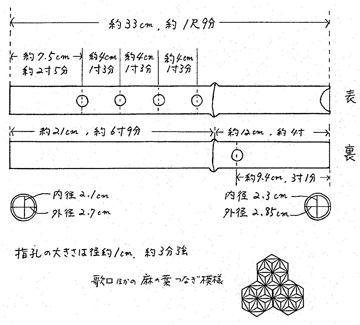
Drawing of Emperor Go-Daigo's shakuhachi with dimensions given.
Source: Ide Yukio, 1992.
暮露暮露 - BORO-BORO
梵字 - BONJI
1319-1333: 'BORO-BORO' described in the TSUREZUREGUSA
"At a place called Shuku-gawara many boro-boro priests were once assembled praying for salvation, when a strange priest entered and asked,
'Pardon me, but is there anybody here known as Iro-oshi Bō?'
One from among them answered, 'I am Iro-oshi; and who may you be, who speak thus?'
He said, 'They call me Shira Boji, and I have heard that my teacher, whom men call so and so, has been murdered in the eastern provinces by a mendicant priest called Iro-oshi.
I am hoping to come across this person, so as to take revenge
on him, and that is why I asked.'
Iro-oshi said, 'Your request is indeed a gallant one. What you have heard did take place. But if we were to meet face to face here, we should defile this sacred spot;
let us therefore adjourn to the dry bed of the river here in front.
Ho! good friends, pray do not help either of us; for if too many get embroiled in this, it will interfere with the Buddhist services.'
Settling it thus, both men went down together to the river bed and ran each other through to their heart's content, till they both died.
I fancy there were no people called boro-boro in ancient times, and that the name has been recently derived from the boronji, bonji, and kanji priests.
Alas! that men such as these who pretended to have cast the world aside should be so strongly self-willed, and while professing to seek the Path of Buddha should be
given to fighting. But though their conduct seems shamelessly obstinate, I consider them worthy of praise; for heedless of death they did not cling to their lives.
I record the incident just as it was told to me."
Chapter 115 in the 'Tsure-zure-gusa', "Essays in Idleness",
written in 1319-1331 by Yoshida Kenkō, 1281/1282-1350.
This translation by William N. Porter, 1914, 1976.
Also translated by Donald Keene, 1967, 1998.
1320:
The 'Rinzai Roku' is printed/published in wood block print in Japan for the first time.
Sources: Hosaka Hiro'oki, 1994, p. 193, and the Yamato Hōmei website.
1322:
元亨釈書
GENKŌ SHAKUSHO
"The Genkō Period Account of Buddhism" (in Japan)
By the Rinzai Zen monk Kokan Shiren,
虎関師錬, 1278–1347
A Famous Myth about the Late 12th Century "Zen monk" Kakua 覺阿 Playing a Flute
禪
の
笛 - ZEN no FUE
Important note: This anecdote is apocryphal! That event most probably never took place.
- - -
嘉應帝聞阿禪行召問宗要。
阿横一笛吹之應制。
時機未稔君臣莫測。
惜哉化行不聞乎。
" - - - In the Kaō Period [1169-1171] the Emperor [Takakura, r. 1168-1180] heard of [Kaku-]A's Zen practice.
[He] summoned [the monk to the court] and inquired about the essentials of the sect.
[Kaku-]A - [who by his] side [was carrying] a flute - blew it in response to the Imperial command.
The times not yet being ripe, the Emperor and his retainers did not fathom [the essence of Kakua's teaching].
Regretful indeed! [Kakua] left and was not heard from [again], was he?"
This story about the Rinzai Zen monk Kakua, b. 1142, has been
preserved in the 'Genkō shakusho', the oldest extant account of
Buddhism in Japan written by the Rinzai monk Kokan Shiren,
1278-1346, completed in the second year of the Genkō Period: 1322.
Trsl. by Torsten Olafsson, 2010.
Although the story is apocryphal - the event most certainly never
took place - at least some facts about Kakua's life are known:
Born in 1142, Kakua first studied Tendai Buddhism on Mt. Hiei.
Having heard of the influence of Ch'an in China, however, in 1171
he went to the mainland to become a disciple of Hsia-t'ang Hui-yüan,
1103-1176, at the temple Ling-yin-ssu in Hang-chou, S. China.
Hui-yüan's master was the famous Yüan-wu K'o-ch'in, 1063-1135.
Receiving his master's Dharma seal, 'inka', in 1175, Kakua returned
to Japan and spent the remainder of this life as a recluse on Mt. Hiei.
Do note that Kakua is recorded to have played a 'fue'
一笛,
most probably a transverse flute - not a shakuhachi.
Besides, there is a discrepancy between the dates:
The Kaō Period ended in 1171 and was succeeded by
the Shōan, 1171-1175, and Angen, 1175-1177, periods.
Kakua returned from China only in 1175, so ...
References: Kraft, 1997, p. 49; Dumoulin, 2005, p. 7;
Baroni, 2002, p. 173; Zengaku Jiten, p. 170.
The complete entry about Kakua in the 'Genkō shakusho' can be
found here (PDF): Kakua entry in the 'Genkō shakusho', 1322
The WIDESPREAD URBAN STORY VERSION of the MYTH:
Here you certainly experience what the Danish 19th century fairy tale writer H.C. Andersen described as "a single feather growing into five hens":
"In an old Zen story it has been said that a certain monk named Kakua was asked to appear before the Emperor and explain the essence of Zen.
Kakua arrived at the court and stood quietly before the Emperor and all his esteemed advisors and courtesans who had all gathered to hear this renowned teacher.
After standing for a long period in silence, during which time the court grew agitated, Kakua removed a bamboo flute from the folds of his robe, blew one short single tone,
bowed politely and left. He returned to the mountains where he was seldom heard from again."
Quotation from Stan Richardson's web page
www.stanrichardson.com/article_1.html.
1330s:
兩頭俱截斷 - RYŌTŌ KU SETSUDAN
"Cut Off (Your) Dualism"
明極和尚行状録 - MINKI OSHŌ GYŌDŌROKU
Early 1330s - "The Recorded Deeds of Abbot Minki"
Important note: This anecdote is apocryphal!
楠木正成亦前往廣嚴寺參見問曰:
「生死交謝時如何」?
楚俊曰:
「兩頭俱截斷,
一劔倚天寒」
"Some time ago Kusunoki Masashige [1294-July 4, 1336] journeyed to the Kōgon Temple [in Kōbe, present Hyōgo Prefecture] to pay a visit,
asking for advice,
'At the time when facing one's death, what to do?'
Answered Soshun [the master],
'Cut off (your) dualism; a single sword rests against the heavenly cold."
Trsl. by T.O., 2013.
In 1970/1973, in his important book "Zen and Japanese Culture", the honorable Daisetzu Teitarō Suzuki translated this anecdote,
commenting in the following way:
"Kusunoki Masashige (1294-1336) came to a Zen monastery at Hyōgo [in the 5th month of 1336] when he was about to meet the overwhelming army of Ashikaga Takauji (1305-1358)
at the Minatogawa, and asked the master,
'When a man is at the parting of the ways between life and death, how should he behave?'
Answered the master,
'Cut off your dualism, and let the one sword stand serenely by itself against the sky!'
This absolute 'one sword' is neither the sword of life nor the sword of death, it is the sword from which this world of dualities issues and in which they all have their being,
it is the Vairocana Buddha himself. You take hold of him, and you know how to behave where ways part."
T.O. comment as of December 17, 2013:
Today, while leisurely Googling, I suddenly, finally, located the actual Japanese text which D.T. Suzuki presented to us in translation and commentary more than 40 years ago - in his book "Zen and Japanese Culture".
It turns out, acc. to Wikipedia Japan, that the above story about the famous samurai general Kusunoki Masashige is actually included in a Japanese book known as
"The Recorded Deeds of Abbot Minki" (see kanji and pronounciation in the above).
Minki Soshun is the Japanese name for the Chinese Rinzai Zen monk Ming-chi Ch'u-chun,
明極楚俊, 1262-1336, who appears to have emigrated from China to settle in Japan in 1329, soon to be bestowed on him very high offices at several Rinzai Zen temples in Kyōto, by Imperial command.
Supposedly, were we to trust the source, Minki Soshun was staying at the Kōgon Temple in Kōbe (in the 5th month of 1336) when Kusunoki Masashige payed him a visit there,
with the purpose of seeking spiritual guidance.
The truth is, however, that the Kōgon Temple was first built and completed the year after that famous battle,
and Kusunoki Masashige's death, in 1336 - in other words: the event could never have taken place (source: Wikipedia, Japan - see link below).
Anyhow, as of today the official name of Kōgon-ji is, in fact: Kusunoki-dera,
楠寺.
Links:
Wikipedia, Japan: Minki Soshun
Wikipedia, Japan: Kōgon-ji
貴人 - KIJIN
15th CENTURY:
1408: "Ōei 15:
On the evening of 24th day Emperor Gokomatsu [r. 1392-1412], who was attending the Palace in the Northern Mountains [Kinkaku-ji],
was summoned by the shōgun Ashikaga Yoshimitsu to be generously entertained with various 'haya-uta' like f.i. "The Flower Pavillon", "Blessing the Fig Tree",
"The Banquet", "The Lotus" - - - , and
furthermore, when - on the 25th and the 27th - when he had amused himself with the performances of various shira-byōshi song-and-dance scenes like
'Long Live the Sovereign' and 'The Five Elders', the music festival was concluded with [a piece performed by] shakuhachi players from the Kamo Shrine."
Quoted from the 'Noritoki gyōki', 1405-1410, by Yamashina Noritoki,
n.d. Trsl. by Torsten Olafsson.
Source: Nishiyama Matsunosuke, 1976.
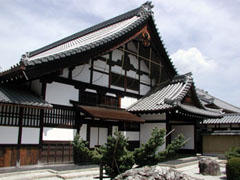
Present-day Daitsū-in, Shōkoku-ji, Kyōto
1425: Ōei 32, 19th day of the 4th lunar month:
"The courtier Naganori came to visit me. In order to enhance the amusement, he brought with him something to drink. So, while sitting facing one another, conversing leisurely,
we had plenty of cups.
Then, asking Naganori to play the shakuhachi, I handed over to him a precious, hexagonal wooden shakuhachi - an exquisite treasure of the Daitsū-in - and in return,
in the humblest of manners, he expressed the deepest gratitude for my giving him the present."
Quoted from the diary 'Kammon gyōki', 1417-1449
by Imperial Prince Sadanori (Fushimi no Miya no Sadanori
Shin-ō/Gosukōin], 1372-1456.
Trsl. by Torsten Olafsson. Source: Koji Ruien.
Acc. to Eta Harich-Schneider, 1973, biwa musicians and "itinerant
flute players" are mentioned in an entry dated August, 1423.
Daitsū-in is a subtemple of the important Zen temple
Shōkoku-ji in N. Kyōto which already during the
Muromachi Period ranked among the Kyōto Gozan,
or "Five great Zen temples of Kyōto".
1446, April 4:
尺八
の
能 - SHAKUHACHI no NŌ
"Bun'an 3, 17th day of the 3rd lunar month:
On the seventeenth, Prince Sadatsune was invited to the performance [at the Jūshin-in temple in Nara], and,
after Kangen music and other offerings, Dengaku Noh was performed.
The program began with the ceremonial pieces Chūmonguchi, Binzasara (in which the special instrument binzasara was used),
Tachiai, and Katana-dama (juggling with several swords), after which the following ten Noh plays were presented:
The Shunkō Gate Atsuta (Atsuta no Shunkō-mon), Trial of Women (Onna-zata), A lunatic at Kitano (Kitano Monogurui), Bamboo Flute (Shakuhachi),
Bird Chaser or Clapper (Naruko), Scribe (Shosha), Saint Hōnen (Hōnen Shōnin), Ono Komachi, Folding Screen (Byōbu), Sanekata."
Quoted from the 'Bun'an Dengaku Nō no Ki',
文安田楽能記
"Record of Dengaku in the Bun'an Period".
Trsl. by Inoura & Kawatake, 1981, p. 73.
The play 'Shakuhachi', 尺八,
figuring on the list is generally
- among Japanese and Western scholars alike - being acknowledged
as a possible early version of the later Nō-style
dance-kyōgen play 'Rakuami'.
ささめごと - SASAMEGOTO
1463-64:
" - - -
Just recently, there was reportedly someone who wished to study with a certain master of the bamboo flute.
When the master inquired, "Have you played before?" he replied,
"Yes, I have been practicing a little."
Thereupon the master refused him, saying,
"In that case, I am unable to teach you."
An interesting answer, indeed, and one whose moral applies to all the other arts as well.
It is important to realize that the mind that once blundered into the evil path cannot be recalled to its original innocent state."
Quoted from Ch. 16, "Right Teaching and the Individual Poet",
in the treatise on poetry and Buddhism entitled 'Sasamegoto',
1463-64, by the renowned poet-monk Shinkei, 1406-1475.
Trsl. by Esperanza Ramirez-Christensen in "Murmured
Conversations", 2008, p. 58.
田楽 - DENGAKU
1463-1464 - The SASAMEGOTO by SHINKEI
TON'A, The DENGAKU SHAKUHACHI MASTER
" - - -
Ton'a, who played the best bamboo flute [shakuhachi] in his day, has said:
'If I stop playing for three days, the right sound would not emerge.'
This is something to keep in mind in all the various arts.
- - - "
Quoted from Ch. 25, "Constant Practise is Decisive",
in the treatise on poetry and Buddhism entitled 'Sasamegoto',
1463-64, by the renowned poet-monk Shinkei, 1406-1475.
Trsl. by Esperanza Ramirez-Christensen in "Murmured
Conversations", 2008, p. 77.
In her notes for Chapter 25 of Shinkei's 'Sasamegoto',
Esperanza Ramirez-Christensen clarifies as follows, p. 251:
"In the critical essay 'Hitorigoto', Shinkei lauds Ton'a (d. ca. 1457-60)
as the foremost 'shakuhachi' artist in the whole country in the years
before the Ōnin War [1467-1477]. - - - "
観念 - KANNEN
"Shinkei recounted the following. Among Sōa’s disciples, the one called Ton’a was a master whose art surpassed even his teacher’s.
Among Ton’a’s disciples in turn was the man called Priest Jōzen. When someone asked Ton’a to appraise this priest’s music, he answered,
"He surpasses me both in the quality of his sound and in dexterity, but he is nevertheless inferior to me." Asked what this could mean, he replied,
"Living as I do apart from the world, I know nothing of flowers and colors but feel in all things the pain and sorrow of mutability.
I play with this contemplation [kannen
観念] in my heart, and consequently everyone is drawn to my music.
Now that priest, being rich, noble, and perfect, has none of this sensibility and therefore his music lacks all appeal."
This means that in both waka and renga, it is essential in every verse to have this contemplative spirit [kannen no kokoro]."
Quoted from the 'Kensai zōdan',
相談兼載,
by Shinkei's poetry student
Inawashiro Kensai,
猪苗代兼載, 1452-1510.
Trsl. by Esperanza Ramirez-Christensen in
"Emptiness and Temporality", 2008, p. 137.
Also translated by Steven D. Carter in Carter, 2001, p. 329.
Do note, that although kannen may well be translated as "meditation", the term is not connected with Zen Buddhism in particular - rather on the contrary.
Kannen-nenbutsu is, in fact, a Pure Land Buddhist practice wherein the devotee keeps the image of Amitābha Buddha in mind.
This term is opposed to kushō-nenbutsu: the oral invocation of the Buddha's name.
増阿 - TON'A
"Shinkei said: "Among the sons of Zōa
増阿 was a man named Ton'a
頓阿, a master of the flute (shakuhachi
尺八) who was more skillful than his father.
Among Ton'a's disciples was one called Jōsenbō
定泉坊.
When someone asked his opinion of Jōsenbō, Ton'a replied, 'His tone and skill both exceed mine; yet still he is inferior.'
When the person asked why, Ton'a replied, 'Having cast aside the world, I have no attachments and know the sadness of transience that permeates all things.
It is that sense of resignation in my playing that draws people's interest. Jōsenbō is wealthy and successful;
he knows nothing of such things and what he produces holds no such interest.'
In uta and renga, too, every verse should convey such a sense."
Quoted from the 'Kensai zōdan' by Shinkei's poetry student Inawashiro
Kensai, 1452-1510. Trsl. by Steven D. Carter, 2001, p. 329.
In his notes for the above translation Steven D. Carter clarifies
as follows:
"I have not been able to identify Zōa. Shinkei mentions a musician
of the same name in 'Hitorigoto' (1468), p. 307.
Shinkei identifies this Ton'a - not to be confused with the prominent
fourteenth century poet of the same name - as the disciple rather than
the son of Zōa. 'Hitorigoto', p. 307.
Shinkei notes that he died "about ten years" ago, which would
mean around 1458. Jōsenbō also cannot be identified."
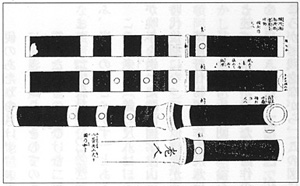
Drawing of a 'hitoyogiri' shakuhachi named 'Rōjin'
(alt. 'Rōnin'), "Old Person", allegedly made by Ton'a
and owned by the poet Sōchō, 1448-1532
Printed in the 'Senshin shūzō gyokuseki zasshi', 1843-1844,
compiled by Kurihara Nobumitsu, 1794-1870
Book preserved at the Seikadō Bunko Art Museum, Tōkyō
Reproduced in Ueno, 2002, p. 125
題頓阿弥尺八像
尺八吹耒感鬼神
乾坤游客更無倫
森羅萬像只斯曲
畫出扶桑笛裡人
"PORTRAIT OF TON-AMI WITH A SHAKUHACHI -
Shakuhachi music stirs up both gods and demons.
Once again the world's number-one rake lacks a friend.
In the teeming universe just that music.
He leaves the painting to enter a bamboo flute."
Poem by Ikkyū Sōjun, 1394-1481, in the 'Kyōun-shū'.
Trsl. by James H. Sanford, 1981, who commented,
"The shakuhachi is a symbol for loneliness here.
Ikkyū has apparently been looking at a portrait of
the famous poet, Ton'a (Nikaidō Sadamune, 1310-1384)
[1289-1372, T.O.] and found in him, if not a physical,
at least a spiritual companion."
There is, however, no evidence at all for the supposition
that the poet Ton'a (Nikaidō Sadamune, alt. Tonna)
was a shakuhachi player.
Rather more, Ikkyū was actually praising one particular very famous
mid-15th century flute player who also had the name 'Ton'a'.
*Original out-of-use ideograph has been replaced
with an alternative modern equivalent.
"DAI-TON-AMI SUISHAKUHACHI-ZŌ -
The play of the shakuhachi (even) evokes feeling in ghosts.
As a wanderer between heaven and earth (I am) again without companion (tagui
倫).
In all things there is only this melody - the man steps out of the painting into the flute from the mulberry-island."
Poem by Ikkyū Sōjun, 1394-1481, in the Kyōun-shū.
Trsl. and commented by Max Deeg, 2007, pp. 24-25.
Regarding Ton'a - see also Ueno Katami, 1983, pp. 137-138.
T.O. note: Possibly, the pen name 'Ton'a' [or 'Ton-ami'] connects
this poet with the Jōdō [or, Pure Land] stream of Japanese
Buddhism - not with Zen! The painting is no longer extant.
一休宗純 - IKKYŪ SŌJUN - 1394-1481
僧 - SŌ
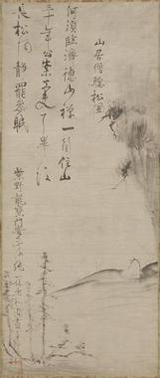
Monk in a Landscape - by Ikkyū Sōjun
15th century. The Cleveland Museum of Art
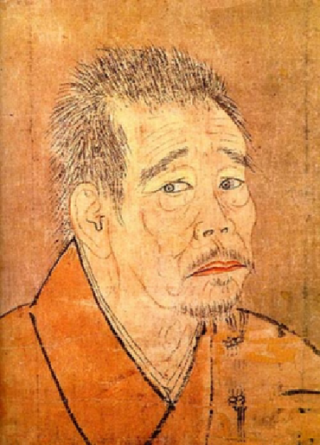
Portrait of Ikkyū Sōjun
- lived 1394-1481
By Bokusai, 15th century
WAKA POEMS ATTRIBUTED to IKKYŪ SŌJUN
なかなかに
われに如かざる
人よりも
只尺八の
声ぞ友なる
"Very much so it is for me
that even compared to the very best person
only the voice of the shakuhachi is really a friend."
尺八は
ひとよばかりと
思いしに
いくよか老いの
友となりぬる
"In just one evening
the shakuhachi made me realize
that for numerous nights to come
it has become like an old friend."
Transl. by Torsten Olafsson, 2010.
Source: Nakatsuka, 1979, p. 66.
宇治 - UJI
IKKYŪ SŌJUN: The Rural Monk in Uji
尺八
因憶宇治庵主曽
餒膓無酒冷於氷
明皇天上羽衣曲
偶落人間慰野僧
"SHAKUHACHI -
Even now I remember the recluse of Uji.
Empty belly, no wine, colder than ice.
Yet, that song of the angel's shining cloak.
Lost among refugees, the rural priest takes comfort."
Ikkyū Sōjun, 1394-1481. Poem in the 'Kyōun-shū'.
Trsl. by James H. Sanford, 1981.
MORE POEMS by IKKYŪ SŌJUN:
普化和尚 - FUKE OSHŌ - "Abbot Fuke"
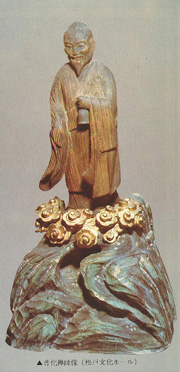
Statue of Priest Fuke - height 32 cm
A treasure of the former komusō temple Ichigetsu-ji now preserved at the
Matsudo Culture Hall, Matsudo City, Chiba Prefecture.
Maker and date unknown. Source: Kikan hōgaku 5, 1975.
贊普化
徳山臨濟奈同行
街市風顛群衆驚
坐脱立亡多敗闕
和鳴隱隱寶鈴聲
"IN PRAISE OF PU'-K'O
Who would walk beside Te-shan and Lin-chi?
That old madman from Chen really startled the crowds.
Some die in meditation, some on their feet,
but he beat them all.
Like a distant bird call, his bell rang faintly."
* Original out-of-use ideograph has been replaced
with an alternative modern equivalent.
"DUALITIES
Buddha's passage into Nirvana came in early Spring.
A single swordstroke sundered mind and body.
Birthless,deatless; Buddhahood is hard to attain.
Duality: Spring flowers blossom, then fall."
"HEARING THE CROW: ATTAINING INSIGHT -
For ten years I was full of discriminations.
Angry, proud, I recall it still.
A crow's laugh; I tasted the arhat's fruit.
Sun-dappled shadows for the lady of Chao-yang."
"LOST IN DREAMS ONE BRIGHT NIGHT I HEARD BOKUSHITSU
PLAY THE SHAKUHACHI AND WAS MOVED -
Bright new moon in the clear Autumn sky.
Over the distant rattle of dancing villagers' drums,
The clear line of the flute turns everything to tears.
Yet startles me from a long, sorrowful dream."
"RETIRING FROM THE HALL
I sing an ordinary, dirty, song,
Of wine-lust, woman-lust, poetry, and plain lust.
I threw aside my old-man's staff and said, 'I give this back to the Eternal.'
Then I played my flute and said, 'This flute knows few companions.'"
"WIND BELLS (Two Poems)
With motion it rings, when still it is silent.
Does the bell hold the sound, or does the wind?
An old monk jangled out of his midday nap.
How is this? The midnight bell at high noon?"
"The realm of sights and sounds is endless,
Yet, imperceptibly, a pure note crystallizes.
That old fellow P'u-k'o knew a trick or two.
Wind and bell hang together, there above the jeweled railing."
明暗 - MYŌAN
普化和尚
議論明頭又暗頭
老禅作略*使人愁
古往今耒風顛漢*
宗門年代一風流
"THE MONK P'U-K'O.
Arguing first at the Bright Head, then the Dark,
That Zen-fellow's tricks fooled them all.
Now, blowing up again, the same old madman,
A sensual youth, howling at the door."
Ikkyū Sōjun, 1394-1481.
Poems in the 'Kyōun-shū'.
Trsl. by James H. Sanford, 1981.
* Original out-of-use ideograph has been replaced
with an alternative modern equivalent.
応仁
の
乱 - ŌNIN no RAN
1467-1477: THE ŌNIN WAR
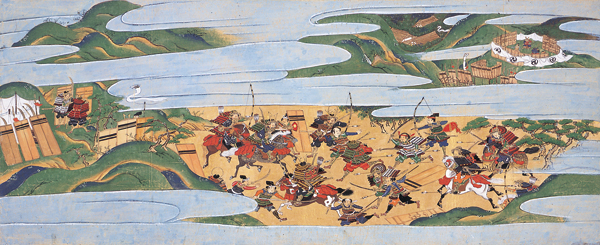
Battle scene from the Ōnin War, dramatically illustrated in the
'Shinyodō engi emaki', "Picture Scroll of the History of the Shinyodō'
A treasure of the temple Shinshōgokuraku-ji in E. Kyōto
Anonymous, dated 1524
By the early 1460s, the Ashikaga Shōgunate, residing in Kyōto, had in reality lost grip of ruling Japan as a central authority.
In 1464, the 8th Ashikaga shōgun Yoshimasa wished to retire and devote himself to aesthetics and the fine arts, in particular: The design and construction of Ginkaku-ji,
"The Silver Pavillon", in NE Kyōto.
Yoshimasa did, unfortunately, have no heir to succeed him as shōgun, so instead he adopted his brother Yoshimi and appointed him his successor.
Only one year later, however, Yoshimasa's wife, Hinotomiko, gave birth to a son, named Yoshihisa.
Two rivalling, powerful daimyō clans, the Yamana and the Hosokawa, now took advantage of the resulting succession dispute as an excuse to overpower each other.
The Hosokawa supported Yoshimi, while the Yamana chose the side of Yoshihisa.
Finally, in 1467, the armies of the two clans clashed in the capital Kyōto itself and warfare soon spread to many of the provinces.
After ten years, in 1477, almost all of Kyōto was laid in ruins; Japan was divided into independent "states", each controlled by the local daimyō.
The "Era of Warring States", Sengoku Jidai, beginning in 1467, was brought to an end only in 1615, when Tokugawa Ieyasu succeeded in defeating his very last opponent,
Toyotomi Hideyori and his supporters, in the Battle of Ōsaka Castle.
- - -
During the Ōnin War, many of Kyōto's centuries old temples and shrines were more or less destroyed by fires.
In 1474, the renowned Rinzai monk Ikkyū Sōjun was designated by Emperor Go-Tsuchimikado as abbot of the important Zen temple Daitoku-ji
in order that he reconstruct the damaged temple which, in 1325, had been converted into a supplication hall for the Imperial court.
Prominent among the financial contributors to the realization of the enterprise were wealthy merchants of Sakai, present-day Ōsaka.
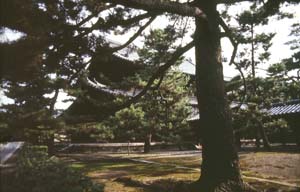
The Daitoku-ji Butsuden (Hondō), or "Buddha Hall"
Build in 1665 (Kambun 5) as a donation from the wealthy
Kyōto merchant Nawa Jōyū
Photo by Torsten Olafsson, 1977
1474 - IKKYŪ SŌJUN - ABBOT of DAITOKU-JI
明頭来 明頭打 - MYŌTŌ RAI - MYŌTŌ DA
暗頭来 暗頭打 - ANTŌ RAI - ANTŌ DA
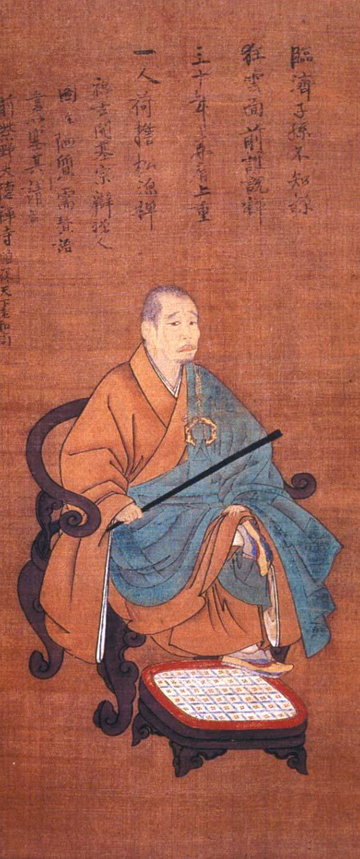
Ikkyū Sōjun. Appointed abbot of Daitoku-ji in 1474.
Artist so far unidentified. 15th century.
室
明頭来 明頭打、
暗頭来 暗頭打、
四方八面来 旋風打、
虚空来 連架打。
- - -
"IN THE ABBOT'S QUARTERS -
'If a bright-head comes, strike the bright-head;
If a dark-head comes, strike the dark-head.
Whatever direction it comes from
Strike it like a whirlwind.
And if it comes from emptiness, cut it down with a scythe.'
- - -"
Inauguration poem recited by Ikkyū Sōjun when he took the seat
as abbot of the Daitoku-ji in Kyōto in 1474,
on the 16th day of the second lunar month (trad. calendar).
Preserved in the 'Kyōun-shū'.
Trsl. by James H. Sanford, 1981.
1474:
According to one extraordinarily prominent eyewitness at that very 1474 Daitoku-ji inauguration event,
Tōyō Eichō, this features part of his reporting at the time:
In Volume 1 of the Shōrin mukuteki, one finds a very interesting passage that mentions both Ikkyū Sōjun playing the shakuhachi
- and: The "grandeur" of Priest Fuke whose anti-Dualism Myō-An poem Ikkyū is known to have recited at the inauguration ceremony at Daitoku-ji in 1474.
Acc. to Tōyō Eichō, he actually witnessed Ikkyū Sōjun playing the shakuhachi (not the 'hitoyogiri'!) in the Zen temple Daitoku-ji in Kyōto
on that very day, in late 1474, when Ikkyū entered and took over the Abbot's Quarters of the temple to become its rebuilder and restorer.
Tōyō Eichō recorded as follows,
不寒臘後
看一休和尚
入牌祖堂正宗滅却。
- - -
狂雲吹起寶山巓。
"In the not cold Winter,
after the offering ceremony held on the third Day of the Dog after the Winter solstice [12th month, 1474],
I saw Abbot Ikkyū as he entered beneath the sign board of
the Founder's Hall [of Daitoku Temple in Kyōto]
after its destruction [in the Ōnin War, 1467-1477].
- - -
Kyōun [Ikkyū's literary name] blew forth [the tune] Hōsanten, "Summit of the Treasure Mountain"."
Link to the full text in question:
Shōrin mukuteki, Chapter 1.
That particular passage is so far awaiting a complete, final translation and commentary.
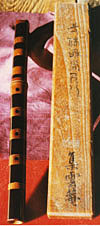
Ikkyū Sōjun's putative shakuhachi
preserved at the Daitoku-ji subtemple
Hōshun-in in Kyōto.
Source: Morimasa Horiuchi's Myōan weblog
EPILOGUE: TWO IKKYŪ POEMS
" - - - The whole of the world
Is but an illusion.
'Death' too is a lie."
- - -
"The deep questions we write out
Are but marks in a dream.
When we awake, even the questioner is gone."
"Fourth month, 8th day of 1457. Written at Daitoku-ji in Japan by Sōjun called Ikkyū, 7th in the line of Hsü-t'ang."
Ikkyū Sōjun. Lyrical prose poems in the 'Gaikotsu'.
Trsl. by James H. Sanford, 1981.
Link to the next page:
Japan 3 • 1477-1560
Link to the previous page:
Japan 1 • 600-1233
List of references:
Sonja Arntzen, translator: Ikkyū and the Crazy cloud anthology,
a Zen poet of Medieval Japan. Foreword by Shūichi Katō.
University of Tokyo Press, Tokyo, 1986.
Baroni, Helen Josephine: The illustrated encyclopedia of Zen Buddhism.
The Rosen Publishing Group, Inc., New York, 2002.
Christopher Blasdel & Kamisangō Yūkō:
The Shakuhachi. A Manual for Learning.
Printed Matter Press, Tokyo, 2008.
Available at www.shakuhachi.com.
Steven D. Carter: 'Chats with the Master:
Selections from "Kenzai Zōdan".'
In: Monumenta Nipponica, Vol. 56, No. 3 (Autumn, 2001),
pp. 295-347.
Max Deeg: 'Komusō and "Shakuhachi Zen". From Historical Legitimation
to the Spiritualisation of a Buddhist denomination in the Edo Period.'
In: 'Japanese Religions', Vol. 32 (1 & 2): pp. 7-38, 2007.
Heinrich Dumoulin: Zen Buddhism. A History. Volume 2: Japan.
Trsl. by James W. Heisig & Paul F. Knitter.
World Wisdom, Inc., Bloomington, Indiana, 2005.
Gunsho Ruijū, Vol. 28. First published in 1733 by Hanawa Hokiichi.
Zoku Gunsho Ruijū Kankōkai, Tokyo, 1933.
Eta Harich-Schneider: A History of Japanese Music.
Oxford University Press, London, 1973.
Carolyn Martha Haynes: Parody in the maikyōgen
and the monogurui kyōgen. Ph.D. thesis.
Cornell University, 1988. Pages 102-131 & 268-271.
Available online at https://secure.umi.com
Cat. no. AAT 8804579.
Frank Hoff: Song, Dance and Storytelling: Aspects of the
Performing Arts in Japan.
Cornell East Asia Series Number 15, 1978.
Victor Sōgen Hori: Zen Sand. The Book of Capping Phrases for Kōan Practice.
University of Hawai'i Press, Honolulu, 2003.
H. Mack Horton: The Journal of Sōchō.
Translated and annotated by H. Mack Horton.
Stanford University Press, Stanford, California, 2002.
Ide Yukio: 'Chūse shakuhachi tsuikō'.
In: 'Research reports of the Kōchi University. Humanities'.
Vol. 41, 1-10, Kōchi, 1992-12-27.
Ikkyū Sōjun: Kyōunshū.
Facsimile of a late 15th century manuscript.
Ed. & publ. by Okumura Jūbei, Kyoto, 1966.
Ikkyū Sōjun: Kyōunshū, Kyōunshishū, Jikaishū.
Rev. & annotated by Nakamura Tamaki.
Gendai shichōsha, Tokyo, 1976.
Inagaki Misoshiro, chief editor: Myōan Sanjūnana-sei Tanikita
Muchiku-shū. Tokyo, 1981.
Inoura Yoshinobu & Kawatake Toshio: The Traditional Theatre of Japan.
Tokyo, 1981.
Kamei Takahashi & Takaha Gorō, compilers and editors:
Gohon taishō kaihen setsuyōshū
("Setsuyōshū in five versions rearranged and compared").
Tokyo, 1974. 2 volumes.
Donald Keene: Essays in Idleness. The Tsurezuregusa of Kenkō.
Columbia University Press, 1998.
Kikan hōgaku 5, special issue: 'Shakuhachi no miwaku'.
Ongaku no Tomo-sha, Tokyo, 1975.
Kiyū Shōran. Comp. by Kitamura Nobuyo (1784-1856), first publ. in 1830.
Reprint by Seikōkan Shuppanbu, Tokyo, 1933.
Koji Ruien. Ruien Kankōkai, Tokyo, 1896-1914. Reduced size reprint ed.
by Jungū Shichō, Tokyo, 1927-1930. Latest edition: Yoshikawa
Kōbunkan, Tokyo, 1967-1971. Vol. 9: Section on Religion.
Vols. 32 & 35: Sections on Music.
Koma no Chikazane: Kyōkunshō.
Original work completed in 1233. Publ. in 2 vols. by
Nihon Koten Zenshū Kankōkai, Tokyo, 1928.
Kraft, Kenneth: Eloquent Zen: Daito and Early Japanese Zen.
University of Hawaii Press, Honolulu, 1992, 1997.
Kurihara Kōta: Shakuhachi Shikō. Chikuyūsha, Tokyo, 1918, 1975.
Riley Kelly Lee: Yearning for the Bell: A Study of
Transmission in the Shakuhachi Honkyoku Tradition.
Ph.D. thesis, University of Sidney, 1992.
Available online at: www.rileylee.net/thesis.html.
Daigan Matsunaga & Alicia Matsunaga: Foundation of Japanese
Buddhism. Vol. I: The Aristocratic Age. Vol. II: The Mass Move-
ment. Buddhist Books International, Los Angeles, Tokyo,
1974, 1976.
Nakatsuka Chikuzen: Kinko-ryū Shakuhachi Shikan.
Nihon Ongaku-sha, Tokyo, 1979.
Hubert Nearman: Shōbogenzō. A Trainee's Translation of
Great Master Dōgen's Spiritual Masterpiece.
Shasta Abbey Press, California, USA, 2007.
Nishiyama Matsunosuke: Iemoto monogatari.
Chūō Kōronsha,Tokyo, 1971, 1976.
Nishiyama Matsunosuke: Iemoto no kenkyū.
Yoshikawa Kōbunkan, Tokyo, 1982.
Nishiyama Matsunosuke: 'Komusō no ura-omote'.
In: Kikan hōgaku 5, Ongaku no Tomo-sha, Tokyo, 1975, pp. 26-30.
NKBZ 25: Nihon Koten Bungaku Zenshū, Vol 25. Revised and annotated
by Usuda Jingorō & Shimma Shin'ichi. Tokyo, 1976.
NKDJ:
Nihon Kokugo Dai-jiten. Nihon Dai-jiten Kankōkai, Tokyo, 1973-1975.
William N. Porter: The Miscellany of a Japanese Priest.
Being a Translation of Tsure-zure Gusa.
Charles E. Tuttle Company, Rutland, Tokyo, 1914, 1976.
Torsten Olafsson: Kaidō Honsoku, 1628: The Komosō's Fuke
Shakuhachi Credo. On Early 17th Century Ascetic Shakuhachi
Ideology. Publ. by Tai Hei Shakuhachi, California, 2003.
Includes a CD-ROM with the author's complete M.A. thesis on
the same subject, University of Copenhagen, 1987.
Purchasable at www.shakuhachi.com.
Esperanza Ramirez-Christensen: Emptiness and Temporality.
Buddhism and Medieval Japanese Poetics.
Stanford University Press, Stanford, California, 2008.
Esperanza Ramirez-Christensen: Murmured Conversations.
A Treatise on Poetry and Buddhism by the Poet-Monk Shinkei.
Stanford University Press, California, 2008.
William Scott Wilson: The Unfettered Mind. Writings of the Zen master
to the Sword Master. Tokyo, New York, San Fransisco, 1986.
Shūhū Yokō, edited by Mori Hikotarō. Publ. by the Kōkoku-ji,
Yura, Wakayama Prefecture, Japan, 1938, 1981.
Suematsu Kenchō: The Genji Monogatari by Murasaki Shikibu.
London, 1882. Charles E. Tuttle Company, Rutland, London 1977.
Daisetzu Teitarō Suzuki: Zen and Japanese Culture.
Princeton University Press, Princeton, 1970, 1973.
James H. Sanford: Zen-man Ikkyū.
Harvard University Center for the Study of World Religions, 1981.
Takahashi Kūzan: Fukeshū-shi. Sono shakuhachi sōhō no gakuri.
Fukeshū-shi kankōkai, Tokyo, 1979.
Takahashi Tone: Tozan-ryū: An Innovation of the
Shakuhachi Tradition from Fuke-shū to Secularism.
Unpublished Doctor of Philosophy thesis.
Florida State University, USA, 1990. Purchasable at:
www.shakuhachi.com
Tōgi Masatarō & William Malm: Gagaku. Nihon no dentō, Vol. 7.
Tankōsha, Kyōto, 1968.
Tōgi Masatarō & William Malm: Gagaku. Performing Arts of Japan
Vol. 5. Transl. from Japanese by Don Kenny.
Walker/Weatherhill, New York & Tokyo, 1971.
Toyohara Sumiaki: Taigenshō (original dated 1512)
1933 edition, 4 vols., edited by Masamune Atsuo
Nihon Koten Zenshu Kankokai, Tokyo, 1933
The entire 1933 edition may be downloaded
from this location:
www.archive.org
- Cheng Yu Tung East Asian Library, University of Toronto
Tsuge Gen'ichi: 'The History of the Kyotaku.'
In: Asian Music, Vol. VIII, 2. New York, 1977.
Available online at:
www.links.jstor.org
Ueno Katami: Shakuhachi no rekishi.
Shimada Ongaku Shuppan, Tokyo, 3rd impr., 1984.
Ueno Katami: Shakuhachi no rekishi. Revised and expanded edition.
Shuppan Geijutsu-sha, Tokyo, 2002.
Zengaku Jiten, ed. by Jimbo Nyoten & Andō Bun'ei,
Shōbō Genzō Chūkai Zensho Kankōkai,
Tokyo, 1962.
|
|
